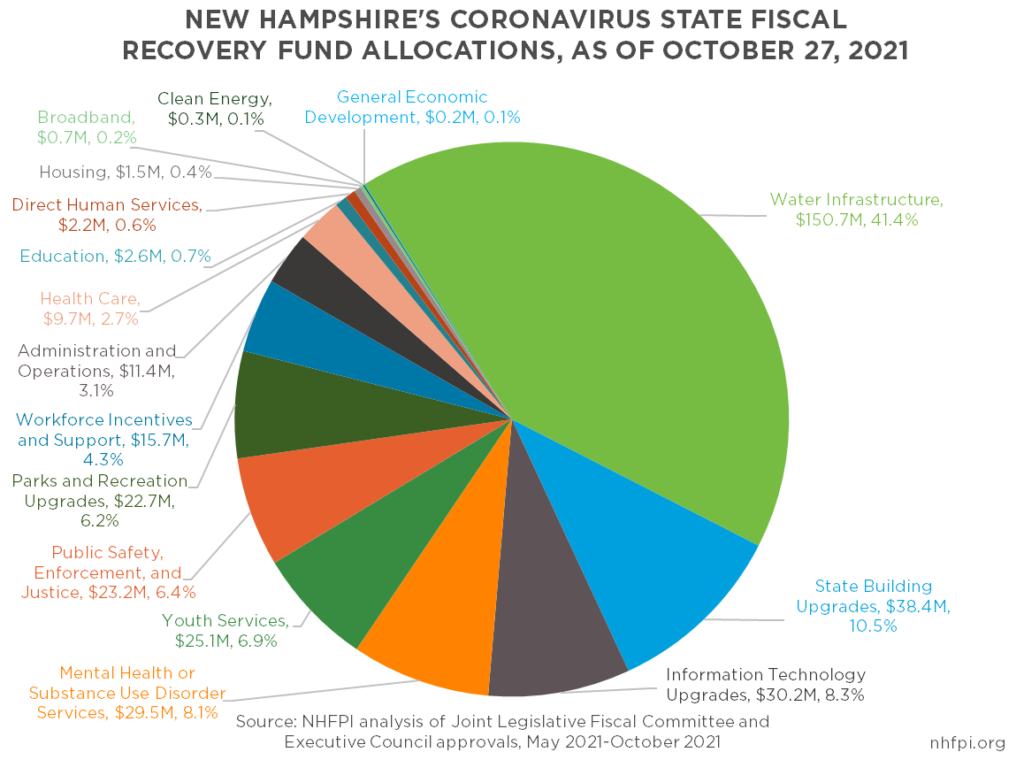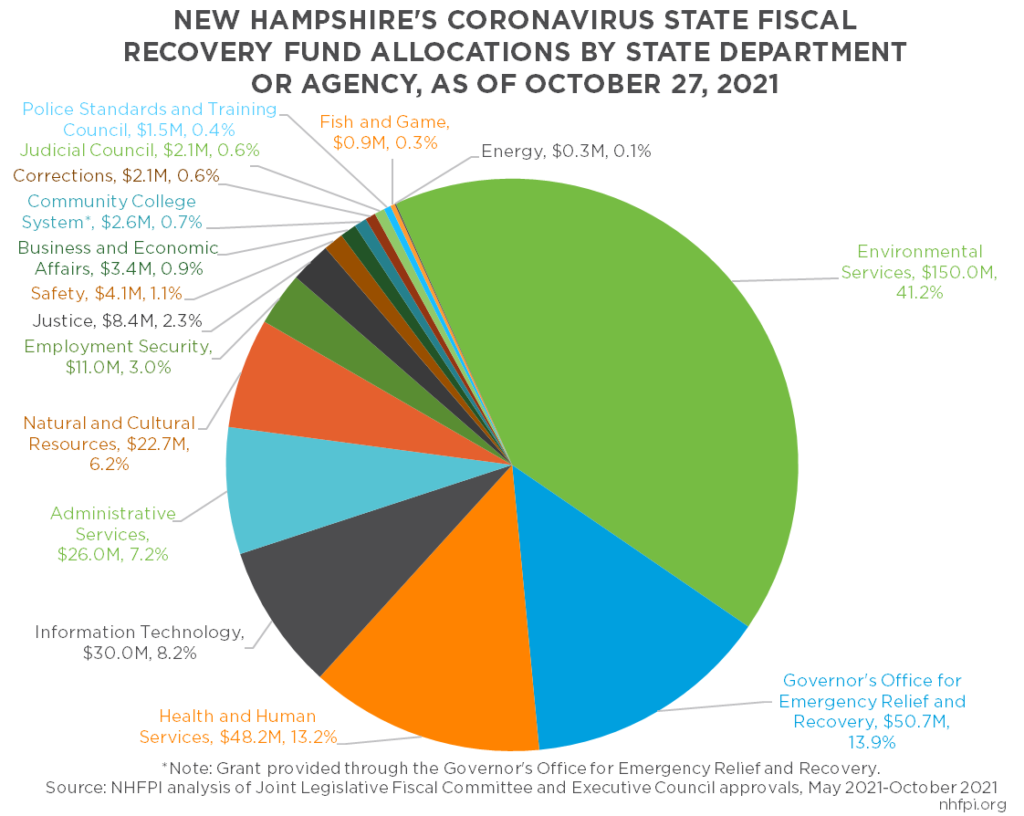New Hampshire policymakers have approved uses for more than one out of every three dollars from the flexible funds allocated to the State government through the American Rescue Plan Act (ARPA). The State government was allocated nearly one billion dollars of Coronavirus State Fiscal Recovery Funds (CSFRF), which are designed to help the State maintain services through the COVID-19 crisis and help people and businesses recover from the health and economic impacts of the pandemic. The funds are also designed to help address the systemic health and economic factors that exacerbated the severity of the pandemic for certain populations, particularly for people with low incomes and people identifying as a racial or ethnic minority. New Hampshire policymakers have thus far appropriated the largest amounts of these one-time funds to capital projects, such as water and wastewater infrastructure, upgrades to State buildings, information technology systems, facilities at parks and recreation areas, and improvements for facilities providing health and human services. The State must use these funds before the end of 2026 or return them to the federal government.
State Appropriations Through October 2021
As of October 27, 2021, the Joint Legislative Fiscal Committee and the Executive Council have approved uses for $363.92 million (36.6 percent) of the $994.56 million in flexible CSFRF appropriated to the State of New Hampshire. These funds were allocated through the approval of requests that came from State executive branch agencies. The current appropriation process for the CSFRF does not include legislators drafting bills or public hearings, but relies on funding requests for programs from State agencies. This process is the regular approval process for the State to modify its budget when federal grants arrive. In the future, the Legislature could modify the process for CSFRF deployment, or appropriate these funds and establish new programs directly, by changing existing law.
At the beginning of September, approximately 20 percent of the CSFRF had been appropriated. Over the course of the meetings since that time, the Joint Legislative Fiscal Committee and the Executive Council have appropriated another $170.2 million. Of that increase, $100 million was appropriated to water and wastewater projects, a specifically-approved use for these dollars under the ARPA statute. This $100 million appropriation was in addition to the $50 million from the CSFRF approved for this purpose in June 2021.
The next largest area of investment relative to the appropriations made before early September were in residential and housing services for youth. Policymakers approved a request from the Governor’s Office for Emergency Relief and Recovery to spend nearly $25.1 million on grants to nonprofits, licensed by the New Hampshire Department of Health and Human Services, to improve facilities used to provide youth residential treatment and transitional living space. The request identified a need to improve facilities to reduce risk of transmission of COVID-19 in a congregate setting while maintaining capacity.
In a significant investment in the State’s mental health care infrastructure, specifically for children, the Joint Legislative Fiscal Committee and the Executive Council approved the use of CSFRF resources for the purchase of Hampstead Hospital, appropriating $15.1 million to acquire the 111-bed facility. The New Hampshire Department of Health and Human Services plans to use the facility to move children out of New Hampshire Hospital. The Department identified a rise in need for mental health services among children due to the pandemic, and identified purchasing the facility at the negotiated price as a less expensive alternative to building a new facility, which would also take more time.
The Governor’s Office for Emergency Relief and Recovery was also granted about $12.6 million from the CSFRF for a matching program to support municipal purchases of safety and emergency equipment, with the State supporting as much as 90 percent of the cost, up to $50,000 of purchased equipment.
The State also requested approval of funds to help boost the number of professional drivers with commercial driver’s licenses in New Hampshire. The New Hampshire Department of Safety reports that there are nearly 3,148 (9.8 percent) fewer of these drivers in the state in July 2021 relative to July 2019, limiting the number of people available to drive commercial shipping trucks, home fuel delivery vehicles, school buses, hazardous materials, and certain other types of vehicles. The Department of Safety will receive nearly $3.2 million to hire four more employees to conduct license examination tests and support the program, as well as for adding testing sites and mobile equipment. In addition, the Department of Business and Economic Affairs will receive $503,003 for marketing and communications to attract and retain commercial drivers, including training videos and advertisements. New Hampshire Employment Security will also receive $1.0 million to support additional payments to recruit and retain private sector transportation employees.
In addition to the funds detailed above, the Joint Legislative Fiscal Committee and the Executive Council have approved allocations since early September that will:
- devote $5 million to support victims of domestic violence and assault
- use $4.7 million to support vaccine distribution that State policymakers had not initially approved to be funded through less flexible federal funding sources
- hire and support more public defenders with $2.1 million to the New Hampshire Judicial Council
- support the Recovery Friendly Workplace initiative and access to peer recovery services with a $1.0 million grant to Granite United Way
More Than 63 Percent of Funds Remain for Investments
With just under two-thirds of the CSFRF dollars provided to New Hampshire not yet appropriated, guidance from the federal government can help policymakers deploy these funds between now and 2026 to maximize the benefit to Granite Staters and minimize the risk of noncompliance. The federal government’s interim final rule is still in effect, and has not yet been comprehensively updated. Dollars spent that would be permissible under this guidance will not be recouped while the interim final rule is effective.
The federal government identified four core funding objectives for the CSFRF:
- “Support urgent COVID-19 response efforts to continue to decrease spread of the virus and bring the pandemic under control”
- “Replace lost public sector revenue to strengthen support for vital public services and help retain jobs”
- “Support immediate economic stabilization for households and businesses”
- “Address systemic public health and economic challenges that have contributed to the inequal impact of the pandemic on certain populations”
The guidance provides relatively broad latitude for use of these funds, and also suggests certain uses, providing detailed examples of permissible deployment of these funds and encouraging recipients to undertake certain activities. While there are limitations, there are also extensive specific examples of permitted activities. For example, the federal guidance expressly permitted the use of CSFRF to help connect people with public services and fund public benefit navigators. These navigators could help community members access available federal, state, or local benefits, many of which are new, expanded, or temporary due to pandemic-related legislation; these recent changes may make applying for these benefits complex and a new experience for many eligible residents. Many of these programs, including food assistance, unemployment compensation, the Child Tax Credit, and the Earned Income Tax Credit, help residents in need while also boosting local, and particularly rural, economies.
The federal government’s guidance specifically notes that the CSFRF can help address “the systemic public health and economic challenges that may have contributed to more severe impacts of the pandemic among low-income communities and people of color.” It also “encourages recipients to consider funding uses that foster a strong, inclusive, and equitable recovery, especially uses with long-term benefits for health and economic outcomes.”
The federal government urges governments to engage their constituents and communities in developing the plans for the use of these funds.
With more than six in every ten of these flexible resources still available for deployment, substantial resources and opportunity remain to help Granite Staters between now and the end of 2026. However, New Hampshire will need to craft and fund initiatives relatively soon to help ensure the completion of long-term projects and the full operation of any new programs and services designed to spur a more robust and equitable recovery.
To learn more about the State’s deployment of CSFRF between June and September 2021, see NHFPI’s September 2021 blog post: Nearly 20 Percent of State’s New Flexible Federal Funds Have Been Appropriated. For more information about permissible uses of the CSFRF, see NHFPI’s May 2021 blog post: Federal Guidance Details Uses of Flexible Aid for State and Local Governments.
– Phil Sletten, Senior Policy Analyst


